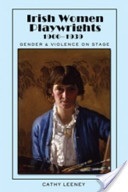
Editor-in-chief: Georges-Claude Guilbert
Book Review Editor: Molly O'Brien Castro
![]()
Cathy Leeney, Irish Women Playwrights 1900-1939: Gender and Violence on Stage (New York: Peter Lang, 2010). £57 (hardback), 265 pages, ISBN 9781433103322 - Patrick Lonergan, Galway.
“In the Irish Dramatic Revival (c. 1897-1926), women characters tend to dominate the stage. Chief among these is W.B. Yeats’s Kathleen ni Houlihan who, in the 1902 play of the same name, is transformed from an old crone into a young woman with the "walk of a queen" by the blood sacrifice of young (male) Irish rebels. Also notable is J.M. Synge’s 1903 In the Shadow of the Glen, which gave us Nora, a woman who is as much real as Cathleen is idealised. Nora experiences the ordinary human feelings of loneliness, desire, hope and despair – and she was therefore greeted with fury by Irish nationalists when Synge’s play premiered. The Sinn Fein leader Arthur Griffith is thought to have been the author of a play called In A Real Wicklow Glen, which set out to show that Irish women are far too virtuous to abandon their marriages, especially in the company of a tramp, as Synge’s Nora does at the end of his play.
Subsequent Irish female characters tend to shift from the polar opposites of Cathleen to Nora and back again. Most prominently, Sean O’Casey’s 1924 Juno and the Paycock would set out to re-imagine Cathleen as Nora, showing that the idealised version of Ireland that Cathleen represented would, in the reality of a war for independence, be superseded by the quiet dignity of Juno and Mary’s determination to raise Mary’s fatherless child by themselves. In short, in modern Irish drama, women characters are often dignified and always thoughtful – as well as being thoroughly fleshed out (in all sense of that phrase). In contrast, the men are feckless, foolish, physically degraded and one-dimensional. Yet women characters are also idealised, acting as icons for male ideology rather than as representations of female subjectivity.
It is of course ironic that these powerful female figures were almost always created by male authors. There were many Irish women dramatists in the first half of the twentieth century: Lady Gregory most famously, but also such figures as Alice Milligan, Winifred Letts, Gertrude Robbins, Rose MacKenna, Dorothy Macardle, Elizabeth Harte, and many others. Yet those writers tended to be taken less seriously than their male counterparts. Their plays were staged for shorter runs than were the works of male authors; they were also less likely to be published, revived, toured, or become the subject of academic books or amateur productions. Indeed, the clearest example of their marginal status was that no-one knew until the 1990s that Kathleen ni Houlihan had in fact been co-written by Lady Gregory.
Such marginalisation has persisted into the present. Between a quarter and a third of all of the Irish plays that are produced every year are written by women. But within that cohort, we find that women authors are considerably less likely to have their plays staged at Ireland’s major venues. Male authors are more than twice as likely to have their plays published as female authors. And on average a male author will have three times as many scholarly articles and books written about him than a female author.
There have been some steps to redress this problem. Melissa Sihra’s 2007 collection of essays Women in Irish Drama includes an appendix that lists every known play by an Irish woman: an extraordinary feat of retrieval and organisation that is in some ways more valuable than the essays in the book, since it shows the variety and breadth of dramas that could potentially be studied and staged. Also important is Susan Harris’s Gender and Modern Irish Drama (2002), a book that – while focussing mainly on male authors – did much to refocus our attention on how gender functions in the Irish theatre, while also devising and deploying a fascinating methodology for the location of Irish drama in its broader cultural contexts (finding evidence to support its analysis of plays in unusual sources such as cartoons, public health notifications, government policy documents, political protests, and so on).
For all of the reasons above, Cathy Leeney’s Irish Women Playwrights is a very important intervention into the field of Irish theatre studies – one that should be widely read, debated, and emulated. Her focus is on five Irish women playwrights, whose lives and works are explored in a loose chronological arrangement: (Lady) Augusta Gregory (1852-1932), Eva Gore-Booth (1870-1926), Dorothy Macardle (1889-1958), Mary Manning (1906-1999) and Teresa Deevy (1894-1963). The book is therefore framed by discussion of two relatively well known playwrights, Gregory and Deevy – about whom there is still much to be written and understood, it must be said. And it also draws to our attention to the plays of three other figures who (as in the case of Gore-Booth) may be better known in other contexts, but whose dramatic work is shown here to be more than worthy of critical analysis.
Leeney’s aim in exploring these writers is, she states early in the book, "to assess the theatrical values at work in their plays, and to explore how they create images on stage of violence in a gendered world" [1]. This is an important clarification at the outset: her objective is not (just) to explore these works as literature (though her attention to textual details is rigorous and careful) but to see the plays in their theatrical contexts: to explore them as plays written for bodies and voices occupying a designed space, and as works that were intended to be performed before an audience that might have a variety of opinions on the matter of Ireland (and hence on the subject of the Irish woman). Leeney also sets out to present "women’s contribution to Irish theatre writing… [as] a counter-tradition that disrupts the totalizing canon of male authors" [4].
That objective has consequences not only for the gendered analysis of Irish writing, but also for our understanding of the status of Ireland as post-colonial. Leeney views the "placing of women as an icon of national value and virtue" [5] as one of the key strategies of Irish postcolonialism – a strategy that in turn effaced the contributions of women to Irish republicanism as well as Irish theatre. As she points out, women made a major impact on the achievement of republican aims, albeit usually in a “supportive and cultural” role [5] rather than through direct violence. This was especially notable in the theatre, where Augusta Gregory’s contribution to the Abbey’s development was indispensable – while the group Inghinidhe na hEireann (daughters of Erin) did much to imagine how performances (including recitals and tableaux) could perform Irishness in more capacious as well as more liberated ways. The achievement of Irish independence in 1922 led to a rewriting of history: women were "represented as icons of this [national] cause, as subservient to it… as exiles in their own country" [6]. The journey that Leeney takes us on from 1900 to 1939 is therefore not one of linear progress but rather of an "early explosion of imaginative vision, followed by a gradual retreat into coded images of resistance, self-censorship and punishment" [6].
This approach to the study of Irish women’s writing will be familiar to many readers, especially in the field of Irish poetry, but what is notable about Leeney’s book is that this analysis has rarely before been applied to a study of Irish theatre in such depth. Drawing on scholars such as Margaret Ward and Elizabeth Fox-Genovese, Leeney sets out to show that the writing of a history of Irish women dramatists should not merely involve "substituting women for men" [11]; a gendered history can instead disrupt the coherent narrative of national formation, making space for the understanding of how conflict and ambiguity function within the theatre – and thus within the wider society. Leeney sees violence as a gendered and ritualised activity that has, in theatrical terms, been heavily explored by male authors. Considering the use of violence in women’s writing thus allows for a demonstration of the effectiveness of her thesis: that the discussion of women’s writing is, as she claims, not just the creation of a gendered history, but the rewriting of all previous histories.
The studies of the five playwrights explore the theme of gender and violence from various perspectives, drawing attention to points of similarity as well as divergence. Lady Gregory, it is acknowledged, "chose to work from within the patriarchal order" – yet although she sometimes can be accused of reinforcing patriarchal values (as with her co-authorship of Kathleen ni Houlihan, for example), she also "resists a dramaturgy of synthesis", refusing to allow audiences to believe that the "dialectical stress between the powerful and the vulnerable" can be ignored [21]. In contrast, Teresa Deevy’s work of the 1930s is ‘most thoroughly a drama and a dramaturgy of alienation, of occluded realities, on the margins of the canon of Irish theatrical history, dealing with issues that were effectively side-lined in the social history of the nation too’ [163]. In other words, one of the key arcs that the book traces is the way in which these five authors chose to negotiate with and against patriarchal norms and systems.
Perhaps because of that process of negotiation, it is unsurprising that many of the plays explored in this book originally went unstaged or have now been forgotten (or both). Lady Gregory’s Grania (published in 1912) was never performed in her lifetime, yet as Leeney shows it is a work that can do much to enhance her reputation as the writer of the commercially useful comedies that would keep the Abbey afloat, thus subsidising Yeats’s tragic and experimental plays. Similarly, Eva Gore-Booth had only two plays produced during her lifetime: Unseen Kings at the Abbey in 1912 and The Sorrowful Princess, which received a school production in 1907. Gore-Booth is perhaps now best known to scholars of Irish literature as a figure in Yeats’s poetry (and as sister to Constance Markievicz); it is unsurprising that Yeats was much more wiling to write about her than actually to stage any of her works (though, to be fair, he did praise and promote her poetry).
Other writers were aware of such marginalisation and sought to contest it. Leeney writes about how Dorothy Macardle sought to reconcile her feminism with her nationalism, by writing a letter to Eamon De Valera which set out to challenge the notorious narrowing of the role of women in the 1937 Irish constitution. As Leeney writes:
Admitting the limits already placed on women through the Conditions of Employment Act (1936) were a lost cause (parts of the Act excluded women from work in a variety of ways, but abolition of these sections was for Macardle “too much to hope for”) she suggest to de Valera a compromise wording, retaining the clause on women’s place being in the home, but qualifying it with a clause giving an assurance that women would not suffer “unfair discrimination on the sole ground of sex”. Despite her tone in the letter, which was one of moderated reason, de Valera ignored her suggestion. [100]
It is interesting that, faced with the unappealing reality of post-independence Irish life, Macardle sometimes did her most interesting work by exploring non-realistic forms of theatre. As has often been observed, to write within a realist tradition risks reinforcing the view that oppressive structures are normal and inevitable; fantasy thus offers the possibility of re-imagining the real.
Another person who struggled with realism was Mary Manning, a writer whose career is in some ways split into the period before and after she left Ireland for the United States in 1938. "Although her contribution to Irish theatre has been intermittent," writes Leeney, "overall it has been wide-ranging and significant, most especially in the 1930s, when she wrote about the new Ireland" [130-1]. Illustrating that point, Leeney dedicates extensive attention to Manning’s play Youth’s the Season? which premiered at the Gate in 1931. Focussing on "Dublin high life, it was a play that discreetly explored issues of censorship and sexuality. Leeney reports Hogan’s remark that "Dublin has never seen a play quite like [it]" [138], and her detailed analysis explains how and why that assessment doesn’t go nearly far enough in establishing Manning’s innovation.
What emerges most coherently from this book is a sense of the radicalism of these five authors, all of whom in different ways sought to use theatrical form to both shape and challenge Ireland, both before and after independence. But what emerges too is the variety of approaches, identities, biographies, interests, and publication histories here – showing the diversity of histories still to be retrieved and understood. And finally what comes through most importantly is that these writers have been neglected, forgotten and sometimes deliberately suppressed – not because of aesthetic, literary or theatrical value but rather because of politics and, put bluntly, patriarchy.
Leeney’s book is an important step towards redressing this situation, and it is poised to stimulate both new scholarship and new productions. It may be a cliché to describe a book as ‘essential reading’, but Irish Women Playwrights genuinely needs to be read by anyone with an interest in Irish theatre, literature, and the society more broadly. It will also make fascinating reading for anyone interested in the overlaps between postcolonialism and gender. Fluently and fluidly written, it is fascinating, stimulating, occasionally troubling, and ultimately very rewarding.
© 2014 Patrick Lonergan & GRAAT

Senior
sub-editor: Hélène Tison
lntison@yahoo.fr
Webmaster: Georges-Claude Guilbert

